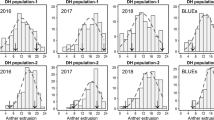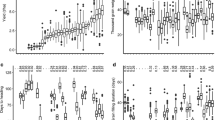Abstract
Allelic effects observed in QTL discovery experiments must be confirmed to be useful in subsequent breeding efforts. Two QTL affecting seed yield of spring hybrid canola (Brassica napus L.) were previously identified in two populations of inbred backcross lines (IBLs) containing germplasm introgressed from a winter cultivar. The effects of favorable alleles at these QTL were retested by crossing two selected IBLs (M5 and M31) to three spring canola lines having different genetic backgrounds. Doubled haploid (DH) lines derived from each F1 were genotyped with RFLP markers flanking the QTL and grouped into the four possible QTL genotypes. For the first field experiment, DH lines derived by crossing the M5 line to one spring line were crossed to two female testers and evaluated as individual testcross progenies in one environment. QTL genotypes had large variances and were not significantly different. A second field experiment was conducted using the DH lines from the first experiment and two other sets of DH lines derived from the M31 line crossed to two different spring canola lines. Individual lines within each QTL genotype of each set were bulked and crossed to the same testers used in Experiment 1. Bulked hybrid seeds of each QTL genotype were planted in a split-split plot randomized block design and 12 replicates. QTL genotypes had smaller variances in this experiment, and the effects of one QTL were confirmed in some genetic backgrounds. These results suggest that bulking of QTL genotypes and use of an appropriate experimental design with many replicates are needed to detect small differences between QTL genotypes.
Similar content being viewed by others
References
Alpert K.B. and Tanksley S.D. 1996. High–resolution mapping and isolation of a yeast artificial chromosome contig containing fw2.2: a major fruit weight quantitative trait locus in tomato. Proc. Natl. Acad. Sci. USA 93: 15503–15507.
Beavis W.D. 1994. The power and deceit of QTL experiments: Lessons from comparative QTL studies. 49th Annual Corn and Sorghum Industry Research Conference. American Seed Trade Association, Washington, DC, USA, pp. 250–266.
Becker H.C., Löptien H. and Röbelen G. 1999. Breeding: An Overview. In: Gomez-Campo C. (ed.), Biology of Brassica co-enospecies. Elsevier Science B.V., Amsterdam, The Netherlands, pp. 413–460.
Butruille D.V., Guries R.P. and Osborn T.C. 1999a. Increasing yield of spring oilseed rape hybrids (Brassica napus L.) through introgression of winter germplasm. Crop Sci. 39: 1491–1496.
Butruille D.V., Guries R.P. and Osborn T.C. 1999b. Linkage analysis of molecular markers and quantitative trait loci in populations of inbred backcross lines of Brassica napus L. Genetics 153: 949–964.
Buzza G.C. 1995. Plant Breeding. In: Kimber D. and McGregor D.I. (eds), Brassica oilseeds, production and utilization. CAB International, Wallingford, UK, pp. 153–175.
Chuong P.V. and Bevesrdorf W.D. 1985. High frequency embryogenesis through isolated microspore culture in Brassica napus and Brassica carinata. Plant Sci. 39: 219–226.
Concibido V.C., LaValle B., Mclaird P., Pineda N., Meyer J., Hummel L., Yang J., Wu K. and Delannay X. 2003. Introgression of a quantitative trait locus for yield from Glycine soja into commercial soybean cultivars. Theor. Appl. Genet. 106: 575–582.
Edwards M. 1992. Use of molecular markers in the evaluation and introgression of genetic diversity for quantitative traits. Field Crops Research 29: 241–260.
Falconer D.S. and Mackay T.F.C. 1997. Introduction to quantitative genetics. Addison Wesley Longman, Harlow.
Ferreira M.E., Williams P.H. and Osborn T.C. 1994. RFLP mapping of Brassica napus using F1-derived doubled haploid lines. Theor. Appl. Genet. 89: 615–621.
Goldberg R.B., Beals T.P. and Sanders P.M. 1993. Anther development: basic principles and practical applications. Plant Cell 5: 1217–1229.
Igartua E., Edney M., Rossnagel B.G., Spaner D., Legge W.G., Scoles G.J., Eckstein P.E., Penner G.A., Tinker N.A., Briggs K.G., Falk D.E. and Mather D.E. 2000. Marker–assisted selection of QTL affecting grain and malt quality in two–row barley. Crop Sci. 40: 1426–1433.
Jefferies S.P., Pallotta M.A., Paull J.G., Karakousis A.K., Kretschmer J.M., Manning S., Islam A.K.M.R., Langridge P. and Chalmers K.J. 2000. Mapping and validation of chromosome regions conferring boron toxicity tolerance in wheat (Triticum aestivum). Theor. Appl. Genet. 101: 767–777.
Kidwell K.K. and Osborn T.C. 1992. Simple plant DNA isolation procedures. In: Beckman J. and Osborn T.C. (eds), Plant Genomes: methods for genetic and physical mapping. Kluwer Academic Publishers, The Netherlands, pp. 1–13.
Kole C., Quijada P., Michaels S.D., Amasino R.M. and Osborn T.C. 2001. Evidence for homology of flowering-time genes VFR2 from Brassica rapa and FLC from Arabidopsis thaliana. Theor. Appl. Genet. 102: 425–430.
Lande R. and Thompson R. 1990. Efficiency of marker–assisted selection in the improvement of quantitative traits. Genetics 124: 743–756.
Lee M. 1995. DNA markers and plant breeding programs. Adv. Agron. 55: 265–344.
Li Z., Jakkula L., Hussey R.S. and Tamulonis J.P. 2001. SSR mapping and confirmation of the QTL from PI96354 conditioning soybean resistance to southern root–knot nematode. Theor. Appl. Genet. 103: 1167–1173.
Lin H.X., Yamamoto T., Sasaki T. and Yano M. 2000. Characterization and detection of epistatic interactions of 3 QTLs, Hd1, Hd2, and Hd3, controlling heading date in rice using nearly isogenic lines. Theor. Appl. Genet. 101: 1021–1028.
Liu B.H. 1998. Statistical genomics: linkage, mapping, and QTL analysis. CRC Press, Boca Raton, Florida, USA, 611 pp.
Littell R.C., Milliken G.A., Stroup W.W. and Wolfinger R.D. 1996. SAS system for mixed models. SAS Inst., Cary, North Carolina, USA.
Mackay T.F.C. 2001. Quantitative trait loci in Drosophila. Nature Reviews Genet. 2: 11–20.
Mariani C., De Beuckeler M., Truettner J., Leemans J. and Goldberg R.B. 1990. Induction of male sterility in plants by a chimaeric ribonuclease gene. Science 347: 737–741.
Mariani C., Gossele V., De Beuckeler M., De Block M., Golberg R.B., De Greef W. and Leemans J. 1992. A chimaeric ribonuclease inhibitor gene restores fertility to male sterile plants. Nature 357: 384–387.
Marklund L., Nyström P.E., Stern S., Andersson–Eklund L. and Andersson L. 1999. Confirmed quantitative trait loci for fatness and growth on pig chromosome 4. Heredity 82: 134–141.
Melchinger A.E., Utz H.F. and Schön C.S. 1998. Quantitative trait locus (QTL) mapping using different testers and independent population samples in maize reveals low power of QTL detection and large bias in estimates of QTL effects. Genetics 149: 383–403.
Monforte A.J. and Tanksley S.D. 2000. Fine mapping of a quantitative trait locus (QTL) from Lycopersicon hirsutum chromosome 1 affecting fruit characteristics and agronomic traits: breaking linkage among QTLs affecting different traits and dissection of heterosis for yield. Theor. Appl. Genet. 100: 471–479.
Romagosa I., Han F., Ullrich S.E., Hayes P.M. and Wesenberg D.M. 1999. Verification of yield QTL through realized molecular marker–assisted selection responses in a barley cross. Mol. Breed. 5: 143–152.
Sax K. 1923. The association of size differences with seed–coat pattern and pigmentation in Phaseolus vulgaris. Genetics 8: 552–560.
Spaner D., Rossnagel B.G., Legge W.G., Scoles G.J., Eckstein P.E., Penner G.A., Tinker N.A., Briggs K.G., Falk D.E., Afele J.C., Hayes P.M. and Mather D.E. 1999. Verification of a quantitative trait locus affecting agronomic traits in two–row barley. Crop Sci. 39: 248–252.
Tanksley S.D. 1993. Mapping polygenes. Annu. Rev. Genet. 27: 205–233.
Thoday J.M. 1961. Location of polygenes. Nature 191: 368–370.
van Berloo R., Aalbers H., Werkman A. and Niks R.E. 2001. Resistance QTL confirmed through development of QTL–NILs for barley leaf rust resistance. Mol. Breed. 8: 187–195.
Vladutu C., McLaughlin J. and Phillips R.L. 1999. Fine mapping and characterization of linked quantitative trait loci involved in the transition of the maize apical meristem from vegetative to generative structures. Genetics 153: 993–1007.
Yano M. 2001. Genetic and molecular dissection of naturally occurring variation. Curr. Opin. Plant Biol. 4: 130–135.
Zhao J. and Simmonds D.H. 1995. Application of trifluralin to embryogenic microspore cultures to generate doubled haploid plants in Brassica napus. Physiol. Plant. 95: 304–309.
Author information
Authors and Affiliations
Corresponding author
Rights and permissions
About this article
Cite this article
Quijada, P.A., Maureira, I.J. & Osborn, T.C. Confirmation of QTL controlling seed yield in spring canola (Brassica napus L.) hybrids. Molecular Breeding 13, 193–200 (2004). https://doi.org/10.1023/B:MOLB.0000018774.72965.2a
Issue Date:
DOI: https://doi.org/10.1023/B:MOLB.0000018774.72965.2a




